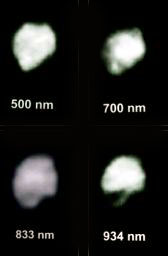3 Juno
|
|
| Discovery A (http://cfa-www.harvard.edu/iau/lists/NumberedMPs.html) | |
|---|---|
| Discoverer | Karl Ludwig Harding |
| Discovery date | September 1, 1804 |
| Alternate designations | B (http://cfa-www.harvard.edu/iau/MPDes.html) |
| Category | Main belt (Juno clump) |
| Orbital elements C (http://asteroid.lowell.edu/) Epoch July 14, 2004 (JD 2453200.5) | |
| Eccentricity (e) | 0.258 |
| Semi-major axis (a) | 399.102 Gm (2.668 AU) |
| Perihelion (q) | 295.949 Gm (1.978 AU) |
| Aphelion (Q) | 502.255 Gm (3.357 AU) |
| Orbital period (P) | 1591.609 d (4.36 a) |
| Mean orbital speed | 18.24 km/s |
| Inclination (i) | 12.972° |
| Longitude of the ascending node (Ω) | 170.127° |
| Argument of perihelion (ω) | 247.890° |
| Mean anomaly (M) | 254.993° |
| Physical characteristics | |
| Dimensions | 233.9 km |
| Mass | 2.824×1019 kg |
| Density | 4.2 g/cm³ |
| Surface gravity | 0.13 m/s² |
| Escape velocity | 0.18 km/s |
| Rotation period | 0.3004 d |
| Spectral class | S-type asteroid |
| Absolute magnitude | 5.33 |
| Albedo | 0.238 |
| Mean surface temperature | ~163 K |
3 Juno (jew'-noh) was discovered on September 1, 1804 by German astronomer Karl L. Harding, using an humble 2-inch telescope. Located in the main belt, it was the third asteroid to be discovered, leading to the prefixed "3" in the official name. It is named after the mythological figure Juno, the highest Roman goddess.
Juno, head of the Juno family of asteroids, is one of the largest main belt asteroids, measuring about 234 km in diameter. It is an S-type asteroid, meaning that it is highly reflective and composed of nickel-iron mixed with iron and magnesium silicates.
According to James L. Hilton (1999), Juno's orbit was observed to change (slightly) in 1839, "very likely" due to an "unmodeled encounter" — that is to say, some other object passed very close to it or actually hit it.
Juno was the first asteroid for which an occultation was observed. It passed in front of a dim star (SAO 112328) on February 19, 1958. Since then, several occultations by Juno have been observed.
In 2003 Juno was imaged by the Hooker Telescope at Mount Wilson Observatory, using adaptive optics. Its diameter was determined to be 267 km, as was its irregular shape, which resembles a potato. Infrared photographs revealed that Juno possesses an approx. 100-kilometre crater, the result of an impact that occurred in the relatively recent past, geologically speaking. Spectroscopic studies of the Junonian surface permit the conclusion that Juno could be the body of origin of ordinary chondrites, a common group of stony meteors composed of iron-containing silicates such as olivine and pyroxene.
References
- James L. Hilton, U.S. Naval Observatory Ephemerides of the Largest Asteroids (1999) (http://aa.usno.navy.mil/hilton/ephemerides/asteroid_ephemerides.html)
- E. V. Pitjeva, Estimations of Masses of the Largest Asteroids and the Main Asteroid Belt From Ranging to Planets, Mars Orbiters And Landers (2004) (http://www.cosis.net/abstracts/COSPAR04/02014/COSPAR04-A-02014.pdf)
| The minor planets |
| Vulcanoids | Main belt | Groups and families | Near-Earth objects | Jupiter Trojans |
| Centaurs | Trans-Neptunians | Damocloids | Comets | Kuiper belt | Oort cloud |
| (For other objects and regions, see: Binary asteroids, Asteroid moons and the Solar system) |
| (For a complete listing, see: List of asteroids. For pronunciation, see: Pronunciation of asteroid names.) |
de:Juno (Asteroid) es:(3) Juno fr:3 Junon ja:ジュノー (小惑星) pt:3 Juno

